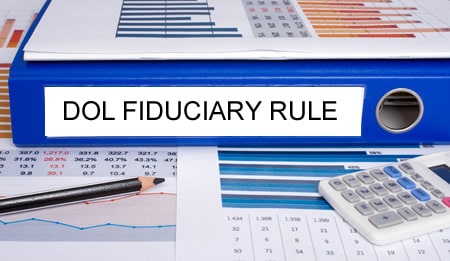
The Department of Labor’s Fiduciary Rule – Three Issues to Consider if you Advise IRAs
By Guest Bloggers, Robert L. Sichel and Amanda M. Katlowitz of K&L Gates
According to the Investment Company Institute, at the end of the first quarter of 2017, assets in IRAs and defined contribution plans totalled $8.2 trillion and $7.3 trillion, respectively.1 Under the Department of Labor’s fiduciary rule, advice to rollover assets from these types of accounts to an account that you advise constitutes fiduciary investment advice. Below are three issues under the Department of Labor’s fiduciary rule that advisers should consider as they engage in rollover discussions with prospective clients.
1. Do I need to obtain information about the prospective client’s existing account?
Yes. Advising someone to rollover assets, whether from a workplace retirement plan or another IRA, to an IRA that you advise is considered fiduciary investment advice under the new rule. To avoid engaging in a “prohibited transaction” on account of earning compensation once assets are rolled over, you may need to comply with the Department of Labor’s Best Interest Contract Exemption. Currently, under the Best Interest Contract Exemption, you must meet certain impartial conduct standards which require that you (a) not make misleading statements, (b) charge no more than reasonable compensation, and (c) act in the best interest of the client. Information about a prospective client’s existing account is needed to formulate advice that is in the client’s best interest. For example, advice should take into account the fees and expenses associated with both the existing account and the rollover IRA as well as the different levels of services and investments available under each option.
2. How should I obtain information regarding the prospective client’s existing account?
You must make “diligent and prudent” efforts to obtain information about the prospective client’s existing account. In some cases, the client will have the necessary information, which may be found on a recent account statement or, in the case of a plan, the summary plan description or a 404(a)(5) fee disclosure notice. If, despite your efforts, the client is unable to provide the necessary information, you may rely on alternative data sources, such as a plan’s most recent Form 55002 or reliable benchmarks on typical fees and expenses for the type and size of plan at issue. If an adviser relies on alternative data sources, the adviser should document the data’s limitations and include an explanation of how the adviser determined that the benchmark or other data used were reasonable.
A number of vendors ranging from well-known names to start-ups are developing tools to assist advisers in obtaining information about a client’s existing account and comparing that information to an IRA that you advise. Some vendors will even help document the reasons why advice was considered to be in the client’s best interest. Advisers may want to consider requesting a demonstration of these offerings to see if the services could be helpful as part of the adviser’s “diligent and prudent” efforts to obtain information about the existing account. Alternatively, a vendor could be used as an alternative data source to fall back on if the adviser cannot obtain the necessary information from the client.
3. What changes, if any, should I make to my policies and procedures?
The party relying on the Best Interest Contract Exemption has the burden to prove that it complied with the exemption’s requirements. Written policies and procedures can be helpful to promote and demonstrate compliance. Existing policies should be reviewed to ensure that you have controls around each of the three components of the impartial conduct standards. For example, controls around acting in the best interest of the client may include a process for obtaining information about the client’s existing account. The policies should also describe the process for documenting the reasons why specific advice was in the client’s best interest.
Questions to consider as you review your policies and procedures include: Should a vendor be used to help obtain information about the client’s existing account? Should a form be required to in-take the necessary client information? How is the best interest analysis impacted by (a) a self-directed brokerage window in a workplace plan, (b) the plan sponsor subsidizing the current plan’s administrative costs, (c) a workplace plan that does not allow the client to leave his or her assets in the plan, (d) a client that has the option to roll assets into an account at a new employer’s plan and (e) whether lifetime income options are available under the existing account?
1 https://www.ici.org/research/stats/retirement/ret_17_q1.
2 Plans file a Form 5500 to satisfy annual reporting requirements under ERISA and the Internal Revenue Code. The Department of Labor has a search engine for finding these forms which is available at https://www.efast.dol.gov/portal/app/disseminate?execution=e1s1. Plan administrators are not required to file the Form 5500 until 8 months after the end of the plan year. Therefore, the form may contain stale information.
This communication is for informational purposes only and does not contain or convey legal advice. The information herein should not be used or relied upon in regard to any particular facts or circumstances without first consulting a lawyer.


